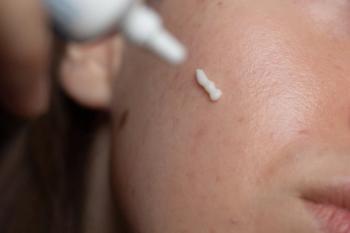
Dermatologic Evaluation Leads to Early Detection of Breast Cancer Metastasis
Key Takeaways
- Dermatologists are crucial in identifying early signs of internal malignancy recurrence through skin evaluations.
- Skin metastases can mimic benign conditions, potentially delaying diagnosis if not properly assessed.
A poster at SDPA highlights that dermatologists play a vital role in early detection of metastatic breast cancer, with skin changes often serving as the initial clue of internal disease recurrence.
A poster presented at the Society of Dermatology Physician Associates (SDPA) Annual Summer Dermatology Conference highlighted the crucial role dermatologists play in detecting early signs of internal malignancy recurrence.1
In the presented case, a skin biopsy provided the first evidence of metastatic recurrence in a patient with a history of cancer, with further imaging confirming widespread metastatic disease.
While improvements in screening and therapies have contributed to a decline in breast cancer mortality rates, the risk of recurrence (25% to 30% recurrence rate) remains significant for many patients.2 Internal metastases often present with systemic symptoms such as pain or jaundice.3 The poster reported that approximately 15% of women diagnosed with breast cancer present with visible clinical symptoms, such as a breast mass or nipple discharge. However, among these, in some instances, skin signs may present as the first signs of recurrence, serving as a crucial clue for clinicians.
Skin metastases tend to manifest as erythematous, pruritic, or nodular eruptions, sometimes mimicking benign dermatologic conditions,4 which can delay diagnosis if not properly evaluated.
The clinical case presented was that of a 70-year-old woman with a history of stage II invasive lobular carcinoma of the breast. She had been in remission for 4 years, with no apparent signs of recurrence. However, she presented to the clinic with diffuse pruritus and later developed a localized redness and rash on her upper back and neck.
A detailed dermatologic assessment, combined with a punch and wedge biopsy of the rash, revealed abnormal lymphocytic cells indicative of metastatic breast cancer. Additional imaging studies confirmed the presence of more widespread disease, including metastases to her bones.
The patient was subsequently referred back to oncology, where her treatment regimen was adjusted to include ribociclib combined with fulvestrant for management of her metastatic breast cancer.
In this case, histopathological evaluation uncovered metastatic disease, prompting further imaging that uncovered extensive osseous involvement.
"Early detection via dermatologic evaluation allowed for rapid intervention and symptomatic management," wrote poster author Sarah Anderson, MPAS, PA-C. "Prompt recognition and biopsy of atypical skin lesions and/or rashes in these patients can significantly impact clinical outcomes by facilitating timely diagnosis and management."
For dermatology clinicians, this scenario emphasizes the importance of maintaining vigilance for signs that may be unrelated to primary skin disease. Recognizing that the skin can be the first site of relapse expands the scope of dermatologic practice from solely treating benign conditions to facilitating early, potentially life-saving diagnosis.
References
- Anderson S. New-onset rash as the initial presentation of metastatic breast cancer. Poster presented at: Society of Dermatology Physician Associates (SDPA) 2025 Annual Summer Dermatology Conference; June 26-29, 2025; Washington, DC.
- Courtney D, Davey MG, Moloney BM, et al. Breast cancer recurrence: factors impacting occurrence and survival. Ir J Med Sci. 2022;191(6):2501-2510.
doi:10.1007/s11845-022-02926-x - Metastatic cancer: when cancer spreads. National Cancer Institute. Updated February 9, 2022. Accessed June 27, 2025.
https://www.cancer.gov/types/metastatic-cancer - Shrivastava N, Balasubramanian A. Cutaneous metastasis in breast cancer: a case series. Cureus. 2023;15(6):e40109. Published 2023 Jun 8.
doi:10.7759/cureus.40109
Make sure to keep up to date with the latest in coverage from the conference and subscribe to Dermatology Times to receive daily email updates .
Newsletter
Like what you’re reading? Subscribe to Dermatology Times for weekly updates on therapies, innovations, and real-world practice tips.


















